
News Stories We’d Hate to See*
Bulldozers Plow Through Trilobite Herd
ALBANY, NEW YORK -- Bulldozers smashed hundreds of square feet of fossil-bearing rock layers northwest of Albany in preparation for an up-scale housing development. The location has long been known as the “Trilobite Herd”, in recognition of the thousands of perfectly preserved fossil trilobites found there. The locality is internationally famous, at least among fossil experts.
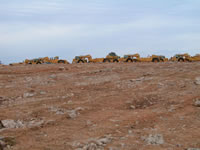 As the dozers roared, protesters marched outside of the
fence surrounding the work site. About 125 people objected to the
wholesale destruction of the rock layers and the ancient trilobites
contained in them. Occasionally one of them would break through and
race across the field to pick up trilobites turned up by the grading.
As the dozers roared, protesters marched outside of the
fence surrounding the work site. About 125 people objected to the
wholesale destruction of the rock layers and the ancient trilobites
contained in them. Occasionally one of them would break through and
race across the field to pick up trilobites turned up by the grading.
Although the leaders of the group have worked hard for over 15 years to ask the city to turn the place into a park or protected reserve, the city council and seven mayors ignored them. Developers recognized that the site, at the top of a beautiful ridge, could be subdivided to make wonderful lots for very expensive homes because of the view over the city. Dilbert O’Shame, the developer’s spokesperson, said that given the need for homes for the expanding population of Albany, this development was necessary.
Piles of shattered trilobites were cast aside by the heavy equipment operators. “We hoped that if we piled them up near the edge of our property, the fossil nuts would be able to collect them and be happy”, said Paul Dawkins, a member of the local Heavy Equipment Operators Union. “We don’t want any trouble, but these people are running in front of the dozers causing all kinds of problems. One day, someone is going to get killed.”
The head of the Geology Department at Albany University noted that this deposit was priceless and should have been protected long ago by state law. “Not only would it have been a scientific resource forever, it would have been a very nice park for the people and guests of the town. It’s gone now, and it’s a great tragedy.”
Edwin Landoskii
Albany Historical Times
Government Officials Drive over Precious Fossils
USGRADISTAN -- The famous fossil beds in rural Usgradistan were virtually destroyed by officials from the Ministry of Finance driving their four-wheel powered rovers back and forth over the beds. Long protected by international agreement, the skeletons of the large extinct mammals, known locally as dragons and scientifically as Titanosaurs were decimated, according to local observers. The eleven men and three women were yelling and laughing as their vehicles sped up the mounds used as pads to launch their vehicles into the air, witnesses said. Each mound had a perfect skull and skeleton at the top of it.
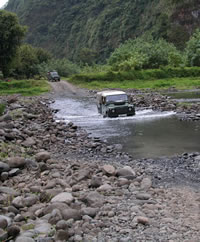 “I suppose there were 20 or 25 of those little hills”,
said Mr. Sameedi, a distraught herder whose own animals had been
stampeded and scattered by the rovers and the joyous screams and
yelling. He said he knew the area was special but didn’t know that the
skeletons were there. “They’re all gone now—I should have looked at
them earlier, but I didn’t know”, he said regretfully.
“I suppose there were 20 or 25 of those little hills”,
said Mr. Sameedi, a distraught herder whose own animals had been
stampeded and scattered by the rovers and the joyous screams and
yelling. He said he knew the area was special but didn’t know that the
skeletons were there. “They’re all gone now—I should have looked at
them earlier, but I didn’t know”, he said regretfully.
The Finance Minister was unavailable for comment, but a source inside the Ministry said that the men and women had just been on a picnic to celebrate their promotions to Sub-Ministers. “You can’t deny them their fun”, the source said. “They’re good people.” One new Sub-Minister, driver of the lead SUV, whose name was withheld, said “No one knows about those things. They should have dug them up. We’re sorry we caused all this furor for the Ministry.”
Archeologists the world over were shocked by the news. Dr. Roberto Vernussi of the EuroMuseum said the losses will set back the science for decades. “We’ll never know now how these magnificent animals died or why. If we could have figured that out, we might have been able to avoid the effects of global warming“, he noted.
Gabor Rasrsaur
YaGoo Internet News Services
Commercial Collector Wipes Out Dinosaurs
PALEO NEWS SERVICE -- Jack Van Vaalan, who makes his living selling fossils to rich people, was stopped with a huge truck full of dinosaur bones by the New Almaden sheriff. The bones were dug up from several places in the deserted hills nearby. “I clean them up, string them all together, and sell the skeletons to various people”, he said.
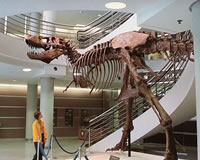 Where do you get them? Mr. Van Vaalan was asked. Waving
his arm in a huge arc, he said “All around here. They’re
everywhere—real common; lot’s of them, ‘nough for everyone”. I just dig
them up for the rich guys because they are too busy to do it
themselves. Anyway can you see those rich guys up there—they’d die of
thirst and sunburn!! Ha, Ha. They mount them on the walls of their
mansions, just like deer heads.”
Where do you get them? Mr. Van Vaalan was asked. Waving
his arm in a huge arc, he said “All around here. They’re
everywhere—real common; lot’s of them, ‘nough for everyone”. I just dig
them up for the rich guys because they are too busy to do it
themselves. Anyway can you see those rich guys up there—they’d die of
thirst and sunburn!! Ha, Ha. They mount them on the walls of their
mansions, just like deer heads.”
Asked how much he sells them for, he replied “Oh depends on the size and type. A big flat one, maybe 3 X 5 meters, could bring more than a million euros because it fits easily on the wall. One mounted in some pose, could bring even more, but there’s less interest in those because you need a really big mansion or castle to show them. T. rexes bring a lot because of that movie.”
Van Vaalan was taken into custody by the sheriff. “Oh, he’ll be digging again next weekend. We can’t hold him really because of loopholes in the law. It’s not against the law to dig those things up if they want to, but you’re not supposed to take them across state or national boundaries”, said the sheriff.
Reporters for Paleo News Service discovered that Van Vaalan has been doing this for 12 years. He digs them up, and then prepares them and poses them in his lab for sale. Apparently the demand for them is quite large. Most of these fossils are museum quality and would make fantastic displays for the children and their parents. “The National Museum should have some of these,” according to Rudi Paratitan, Curator of Dinosaurs at that museum.
Robin Poteryx
Paleo News Service
Vandals Tag Fossil Snails
GROUEN, FRANCE -- In the little village of Grouen, the tilted beds exposed hundreds of big snails known as ammonites. “A bunch of kids, oh, maybe 16, 17 or 18 years old, spray painted all of the fossils. Each big one was decorated with spots, strips or solid paint”, said the mayor, Mr. Grossbeak. “The whole slope looked like a giant modern art picture. Seems like there’s some kind of contest going on between the kids to see who can make the weirdest looking snail.”
 The Mayor was upset because the bed had become a
much-loved tourist attraction. People from all over Europe would drive
here on their way to the beaches to see the fossils, buy bread in our
bakery, eat in the restaurant, and get postcards of them. But now they
will not come.” The local bakery that sold loaves of bread in the shape
of the ammonites reported that sales had dropped precipitously since the
word had gotten out that the fossils had been painted. So did the
nearby Fossil Bed restaurant. The townsfolk now have plans, as yet
undisclosed, to remove the paint from the fossils.
The Mayor was upset because the bed had become a
much-loved tourist attraction. People from all over Europe would drive
here on their way to the beaches to see the fossils, buy bread in our
bakery, eat in the restaurant, and get postcards of them. But now they
will not come.” The local bakery that sold loaves of bread in the shape
of the ammonites reported that sales had dropped precipitously since the
word had gotten out that the fossils had been painted. So did the
nearby Fossil Bed restaurant. The townsfolk now have plans, as yet
undisclosed, to remove the paint from the fossils.
An investigator from the Institut de Paléontologie said that the paint had penetrated into the pores of the rock and that they could not be cleaned by any method he knew. “Weathering naturally may be the only way to do it, although that will take decades, if not centuries”, he said.
All the villagers are deeply saddened by the destruction of their biggest claim to fame.
Iban Sitillites
Nouvelles de la Terre, Paris
FBI Searches Museum for Stolen Goods
FROM CNP.COM -- The FBI today announced that an unknown thief or thieves made off with a collection of about 425 rare objects from the Museum of the Highlands South (MOTHS). Included were a number of valuable trilobites, eurypterids, large modern clams and snails, and an unknown number of fossil bones of various animals.
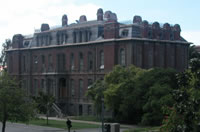 Investigators said it was an inside job. Several agents
are searching MOTHS in the belief that the fossils were hidden someplace
so they could be later removed. They are also questioning the scientists
and staff of the museum.
Investigators said it was an inside job. Several agents
are searching MOTHS in the belief that the fossils were hidden someplace
so they could be later removed. They are also questioning the scientists
and staff of the museum.
Two of the scientists are primary suspects, but the evidence is, as yet, missing. Because of the resale value of the fossils, no one is above suspicion.
The Director of the Museum was unavailable for comment, according to his secretary, Ms. Littlefoot, “because he was out of town collecting some old pots”.
Agent Bob Clammy thought that the fossils might turn up soon for sale on some web site, perhaps ebay or some seller’s site. More likely, he said, they would be sold secretly out of a motel room near the next big fossil convention, held annually in several parts of the country. “Fossils are like gold” he said, “and big dollars are exchanged for them. If we catch the people responsible, they will go to jail for a long time”. Stealing that much is a serious felony he noted. “And if they get caught taking or sending them out of the country, they’ll be in really big trouble.”
The market for fossils is huge. Thousands of them are sold internationally on-line and at fossil and rock shows. Amateurs collect them from the hills themselves. They make interesting collections, especially for young people and retired folks.
Janet Limpetdottir
CNP.COM
Essay Recalling our Past
Local Man Found Ancient Rhinoceros But Now It’s Gone
Rhino Ranch, the Dakotas -- In the Dakotas about ten years ago, I stopped at a rancher’s house to see his relict rhinoceros skull. It was well-known in town, where I learned about it from a waitress at Jumbo’s Diner. She told me that a rancher, known as Big Bill, brought a skull about 2 feet long into the restaurant a week or two before my visit. Naturally, I was interested. So I headed north on the road out of town, as she directed me to do, to the turnoff on a small rutty dirt road. I went along that until I found the tall bridge-like sign over a side road reading “Rhino Ranch."
 Arriving at the door of the ramshackle house, I asked for
Big Bill. A very large burly man replied “That’s me. How can I help ya
all?” “Well,” I began, “I hear you have a large fossil rhinoceros skull.” “Yep, sure do. You wanna see it?” he asked proudly. He was quite
pleased with that skull, so much so that he even named his ranch after
it.
Arriving at the door of the ramshackle house, I asked for
Big Bill. A very large burly man replied “That’s me. How can I help ya
all?” “Well,” I began, “I hear you have a large fossil rhinoceros skull.” “Yep, sure do. You wanna see it?” he asked proudly. He was quite
pleased with that skull, so much so that he even named his ranch after
it.
Knowing something about rhinos, I could tell it was completely new to science, was about 45 million years old, and would fill a gap in the evolution of the group. Big Bill and I talked about it and rhino evolution for over two hour before I brought up the idea that he might donate the skull to the museum down in the city. “Nope, that’s mine and I’m gonna keep it! I sure as heck don’t want it in some musty drawer 200 miles from the ranch.” “Well,” I said, “the paleontologists would name it after you, you know, something like Rhinoceros bigbilli. You’d go down in fossil history and you’d be known far and wide as the donor and namesake of a very important fossil.” “If it’s that important, all the more reason to keep it here, not there. The paleentologies can come here if they want to look at it,” he insisted. After a few more strained pleasantries, I left.
Last week I returned to Rhino Ranch, hoping that Big Bill had changed his mind and that he might yet give that scientifically-valuable rhino skull to the paleontologists. “Hi Big Bill, how are you?” “Good ‘nough, good ‘nough. Yep, things are good. What brings you back here, Ted?” I asked him what he did with that rhino skull he had? He replied, “It was too big for any of the tables and it took up too much room anyway, so I used it as a door stop over there.” “Over where?” I asked, not seeing any skulls. “Oh,” Big Bill said, “it ain’t there no more. We had a bit of a party, really a great BBQ, a few summers ago, and one of my friends seems to have given it a kick, and it shattered to bits. Kinda too bad because I liked it a lot. I even looked around the spread for another one, but never found a replacement. I’m guess I’m gonna have to change the name of the ranch too one of these days now that the rhino is gone.”
So Rhinoceros bigbilli ended in a few piles of chips and bits in the front yard of Rhino Ranch, or whatever it’s called now. It could of and should have been in a museum.
Ted Turnbull
The European
Paleontologist, Ltd.
School Field Trips Ruin Fossil Deposits
MIDDLESEX -- For several years, science teachers at the Middlesex School have taken classes to the Family Quarry on the outskirts of town to dig fossils. Over the years, several hundred middle school children have learned directly about geology, paleontology and biology by digging and cleaning fossils.
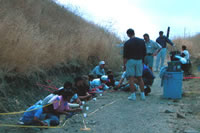 Mr. Art Sniveley, an 8th level teacher,
claimed it was a unique teaching opportunity and his students were far
superior to any others in the county because of the experience. “Yes,
they get dirty and tired but what a way to learn.” “That’s right,”
agreed Ms. Lucy Ignites, the Head Science Teacher. “Our kids learn more
about the earth and life that way than the other schools’ kids do
reading books”.
Mr. Art Sniveley, an 8th level teacher,
claimed it was a unique teaching opportunity and his students were far
superior to any others in the county because of the experience. “Yes,
they get dirty and tired but what a way to learn.” “That’s right,”
agreed Ms. Lucy Ignites, the Head Science Teacher. “Our kids learn more
about the earth and life that way than the other schools’ kids do
reading books”.
The school has been under investigation for 7 months because the teachers violate the Commune’s Conservation laws. “As educational as it is to let the students dig up fossils and take them away, they can’t do that for many more years. The deposit is running out of fossils,” according to the Commissioner of Conservation, Mrs. Tonya McDatum. “Our investigation is complete and we will take it to the local Justice for adjudication within the week.”
Dr. Jamie Ichnosen, a professor of earth sciences at Middlesex University, pointed out that the fossils are very common and are found everywhere, but they are found in living positions only where the students dig. “We will be working on this deposit for many more years, if the students will stop collecting those fossils. Uninformed, ad hoc collecting destroys the information we need. They have to stop.”
Parents, however, are outraged that an esteemed professor and some appointed politicians are conspiring to make criminals of their children. “There’s only rocks and dirt in those holes over there. The little ones are so excited to dig and get outdoors. They shouldn’t be denied. What the heck is so important about a bunch of dead shells and bones that our kids can’t dig them up? Nothing, of course,” said Jonathan Symbioman.
The final decision will be issued after Ramadan, when the court and school reopen.
Sharon Foramkins
Cnidarison’s Foreign News
Service
President Announces New Fossil Collecting Order
Washington D.C. -- The President today announced that he had ordered the Department of the Environment to reverse its regulations forbidding the collection of fossils anywhere in the country. The regulations had been in place for three decades, and they were often the target of much lobbying by fossil sellers, amateur collectors, as well as some professionals and certain companies.
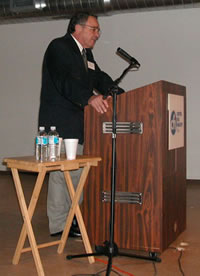 The President, speaking from the Rose Garden, stood
between a table loaded with huge trilobites and the large leg bone of a
dinosaur. He declared that every American had a right to collect
anywhere, anytime, and as much as they wanted.
The President, speaking from the Rose Garden, stood
between a table loaded with huge trilobites and the large leg bone of a
dinosaur. He declared that every American had a right to collect
anywhere, anytime, and as much as they wanted.
Reporters from the Associated Paleo Press asked the President, “Right? Right? What right?” “Well, after all,” the President responded, “it was supposed to be included in the Bill of Rights ya know. Look, Thomas Jefferson wrote that Bill and he collected fossils. He had a bushel of them in his house over there at Monticello—elephants and things like that. Ya otta go see ‘em; I did and it’s a heck of a good show to see them there. It’s kinda nice to have them sittin on the mantelpiece just below your favorite rifle. By gosh, even my ol’ buddy Newt had a dinosaur head in his senate office,” he said. “So you see, there’s a precedent for getting rid of those bad rules—we’re going to correct the Bill of Rights! Now every American dad can take his son into the hills and dig dinosaurs." He pointed to the huge bone "Or tree-lo-bits," (picked a large one off the table).
“Down where I come from, it has always been a fun thing to do—grab an axe and shovel, throw them in the back of your pickup truck, along with some drinks (heh, heh!), and you’ve got yourself a heck of a good ‘xpeedition fer a day or two. Better’n chasing cows! Uhg, ugh. And ya learn stuff about creation and things like that. It’s a good law.”
APP reporter Jan Pojetson asked, “What about the rider to your Order?” The President replied, “Oh that. Yeah, we’re gonna open up some of the parks too for collecting and mineral exploration." "Which ones?" Pojetson asked, but the President did not answer. "Dinosaur, Yellowstone, Death Valley, and a few others were included in the executive order," yelled Pojetson as he waved a copy of the Order at the audience.
“Gotta go now, got some big executives waitn’ in the Oval Office. See ya all later. Yeah, ok, bye, bye,” the President said as he ended the press conference and quickly left the Garden.
Bob Backkerson
Fossils Forever Fund
*What To Do About It?
Our field sites and specimens are
our most valuable resources. They provide data that is essential to the
sound interpretation of ancient life and that cannot be obtained in any
other way. Now both are endangered everywhere in the world. The
International Paleontological Association's new initiative, PaleoParks,
will identify important fossil sites world wide. This database will list
all sites, including those already protected in National Parks, World
Heritage Sites, and GeoParks, among others. It will also list smaller
and private sites in an attempt to tabulate all such sites world
wide. Each PaleoPark will be identified with its particular
values--research, education or recreation. Well-protected sites will be
listed on-line for people who wish to visit or need information about
them. Those without proper protection protocols will remain on the
database but not be accessible to everyone.
IPA will provide assistance and expertise for local professionals to
develop proper protection and conservation for sites deemed important by
local professionals and IPA reviewers. IPA requests your assistance in
identifying sites you believe are important.
For further information and to nominate a fossil site, visit the
International Paleontological Association on-line.
Help the International Paleontological Association’s efforts to protect fossil sites world-wide and the data that they still contain.
